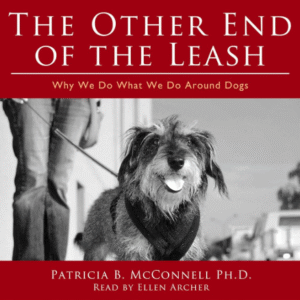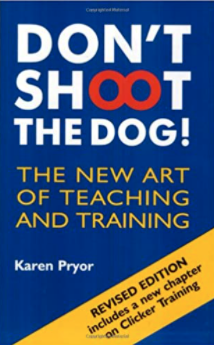The 3 Best Resources for Learning Dog Body Language
Here we will cover how to study dog body language and how to become adept at spotting subtle dog body language cues. Near the end of this article you will find trusted resources for learning the basics of animal behavior, which will help you further interpret the animal body language you see.
There are also a few photos of dog body language you can use to quiz your current knowledge and an answer key at the bottom of this article.
Let’s get started!
Understanding Dog Body Language
The best way to learn about dog body language is to:
- Study pictures of dogs in various situations
- Gain hands-on experience working with as many dogs as possible
- Learn the basics of animal behavior
1. The Best Picture Book for Learning Dog Body Language
One of the best photo books of dog body language is “Canine Body Language: A Photographic Guide:” by Brenda Aloff. This book contains hundreds of images and nearly 400 pages that illustrate a sweeping variety of postures, behavior, and situations a dog may encounter. The world is lucky to have this book!
You will gain a solid foundation and understanding of dog body language by simply thumbing through this book and reading the captions. Brenda Aloff is a professional dog trainer and a skilled author. She writes intuitive interpretations and includes an impressive number of unique pictures that are not available anywhere else.
To my knowledge there is no other book that documents dog body language this well. If you are even slightly interested in learning dog body language, you should buy this book.
How We Use This Book
We use a few photos from this book in our hiring process at our pet sitting company. Seeing the way potential new hires would answer these dog body language questions was one of the most telling portions of the interview.
A good hire could quickly interpret and explain the mood of each dog. The best hires could go further and spot the details. If you study each picture closely you will see more and more subtle cues each dog is offering and you will better understand each dog’s current situation.
Quiz Yourself!
See if you can spot all the details! What is each dog trying to tell you?
Scroll to the bottom of this article to see a summary of Brenda Aloff’s description of each photo.
Picture A
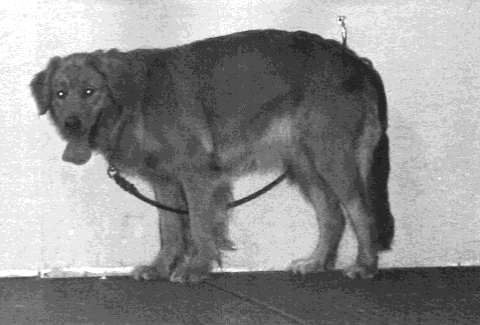
Picture B
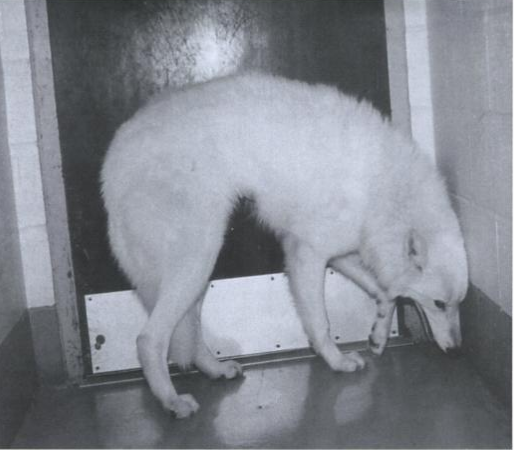
Picture C
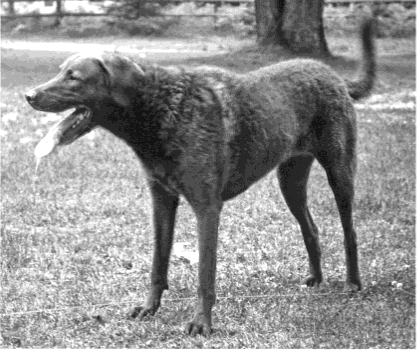
2. Volunteer at an Animal Shelter
There is no substitute to working with dogs in person. You will not have a full understanding of dog body language unless you have hands-on interactions with many dogs in many different situations.
One of the best ways to get in-person experience with dogs (cats and other pets) is to volunteer at your local animal shelter.
Shelters are always looking for Behavior and Enrichment volunteers to:
- Play with dogs, cats, and other pets
- Help walk dogs and to be their buddy
- Help with clicker training
At a shelter, you will be able to interact with and help many animals in a short period of time.
The shelter environment brings out many behaviors in dogs. It is important to remember each animal is responding to a shelter environment and may respond much differently in a person’s home. For this reason, you may also want to consider fostering pets in your home (if possible) after you have gained experience working in a shelter.
As you work with more and more animals you will begin to connect their body language to what you have learned while studying Canine Body Language: A Photographic Guide
3. Study the Basics of Animal Behavior
To better understand the non-verbal communication it is important to study the field of science based animal behavior. As you study animal behavior you will learn how to connect the non-verbal cues a dog expresses to what the dog is trying to communicate.
The field of animal behavior is deep, professionals spend decades learning the nuances. However, understanding the basics can be done within a few months of dedicated study and by gaining experience. The important thing to remember as you get started is to study trusted, science-based resources.
Trusted Resource #1: Ian Dunbar
Animal behavior experts agree that it is important to reject the idea of “Alpha” or “Dominance” based animal training and to learn training methods that take the animals “Point of View” into account. For a primer on the “Dog’s Point of View”, watch Ian Dunbar’s Ted Talk on the subject:
Ian Dunbar has many other trusted resources available on his youtube channel and blog. Be sure to check out both:
As you study Ian Dunbar’s work you will gain a deeper understanding of where a dog’s body language is coming from. Specifically you will learn:
1. The “why” behind the body language. Dunbar is a veterinarian and animal behaviorist who approaches dogs from both a scientific and practical training perspective. He explains not just what a tail wag, ear position, or lip lick means, but why those signals evolved and how they connect to a dog’s emotional state (e.g., fear, excitement, stress). That gives you context so you can interpret signals more accurately instead of guessing.
2. How to see body language as a conversation, not isolated signals. Dunbar emphasizes that dogs communicate in sequences—posture shifts, facial expressions, movement, and vocalizations all work together. His teaching helps you “read” those chains of behavior, so you understand when a dog is escalating toward aggression, backing off, or inviting play.
3. Practical observation skills. Much of Dunbar’s work is designed for trainers and dog owners, so he gives clear, real-world examples: videos, case studies, and step-by-step descriptions of what to look for. This helps you spot subtle early-warning signs—like a freeze, a lip curl, or weight shift—that many people miss until it’s too late.
4, You’d connect body language to training and socialization. Dunbar links reading dogs’ signals with how you should respond: when to reward, redirect, or de-escalate. That way, understanding body language becomes a tool for preventing problem behavior and improving a dog’s comfort and confidence.
5. You’d learn to read context instead of relying on “universal” meanings.
One of Dunbar’s key points is that the same gesture (e.g., tail wag) can mean very different things depending on the rest of the dog’s body language and the situation. His method trains you to factor in environment, prior events, and individual personality before making an interpretation.
Trusted Resource #2 Patricia B. McConnell, Ph.D.
The next resource we recommend is “The Other End of the Leash” by Patricia B. McConnell, Ph.D
This is one of my favorite books. The content is great and it’s available as an audio book, so you can learn all this book has to offer while walking your dog!
Studying The Other End of the Leash by Patricia B. McConnell helps you understand dog body language because the entire premise of the book is about how human and canine communication styles differ—and how to bridge that gap by becoming fluent in the dog’s “language.”
Here’s how it specifically helps:
1. Shows you how dogs read you. McConnell explains that body language is a two-way street—dogs are constantly interpreting our posture, movement, facial expressions, and tone. Understanding how they read us makes it easier to understand how they expect to be read in return.
2. Breaks down canine social signals. She describes tail position, ear position, eye contact, and movement in detail, linking each to emotional states like fear, curiosity, playfulness, or tension. She also explains how those signals fit into canine social rules.
3. Compares human vs. dog communication habits. For example, humans often approach head-on, make prolonged eye contact, and hug—all of which can be threatening or confusing to dogs. By learning these contrasts, you become more sensitive to the signals dogs send back in those situations.
4.Emphasizes context and sequence. McConnell teaches that body language should be read as part of a sequence, not as isolated gestures. A tail wag combined with a crouch, for instance, says something very different than a tail wag with stiff legs and a hard stare.
5. Uses personal stories to illustrate real-life reads. The book is full of case studies and anecdotes from her work as an applied animal behaviorist, showing exactly how subtle cues—like a slight weight shift or glance—predicted what a dog was about to do.
6. Encourages empathy through observation. By putting yourself in the dog’s place and thinking about how they perceive the world, you naturally get better at picking up on and respecting their physical signals.
In short, The Other End of the Leash doesn’t just list dog body language—it gives you the human-canine translation manual so you can read it accurately and respond in a way the dog understands.
Trusted Resource #3: Karen Pryor
Karen Pryor brought clicker training into the mainstream with her book Don’t Shoot The Dog. Studying Karen Pryor’s work helps you understand dog body language with a focus on operant conditioning, observation skills, and timing, which sharpens your ability to read a dog’s signals.
Here’s how you can learn from her work.
1. Sharper observation skills. Pryor’s clicker training philosophy trains you to notice the smallest shift in posture, ear position, weight distribution, or facial expression so you can use a clicker to mark and reinforce the behavior you want. Over time, this constant attention to micro-movements makes you far more sensitive to subtle dog body language.
2. Understanding behavior as communication. Pryor sees all animal behavior—including body language—as information. By studying her methods, you’ll start interpreting not just “obedience cues” but what those physical signs say about the dog’s emotions, motivations, and readiness to engage.
3. Connecting cause and effect. Clicker training depends on perfect timing: mark the instant the dog does something right. To get that timing right, you must learn exactly what the dog is doing in that moment, which builds a habit of reading body position and facial cues in real time.
4. Reinforcing calm, confident body language. Pryor’s methods encourage you to reinforce desirable emotional states. Such as, loose body posture, eye contact, lying down. This means you can actively shape the dog’s body language to be more social and at ease.
Trusted Resource #4 - Jean Donaldson
Jean Dondalson’s book “Culture Clash” covers the misconceptions of the “Disney Dog” and the misplaced anthropomorphization many owners apply to their pets. She also covers dogs “from the dog’s point of view”
Jean Donaldson’s work:
1. Reframes how you see behavior. Donaldson treats body language as a natural expression of a dog’s instincts, not as “naughtiness” or “disobedience.” This helps you interpret what you see without projecting human emotions or morals onto it.
2. Teaches you to avoid anthropomorphism. One of her main points is that humans often misread dogs by assuming they “think like us.” She shows how this leads to misunderstanding signals like lip licking, yawning, or averting gaze, which in dog language can mean stress or appeasement—not boredom or guilt.
3. Links signals to emotional states. Donaldson emphasizes that behavior—including posture, facial expressions, and movement—flows from underlying emotions. By reading those emotions accurately, you can interpret the meaning of the body language in context.
4. Explains conflict and stress signals. She discusses how aggression, fear, and avoidance often start with very subtle cues (like a freeze or stiffening) before they escalate. You learn to spot these early signs so you can prevent full-blown reactions.
5. Integrates observation with training. In Culture Clash, body language isn’t studied in isolation—it’s directly tied to how you teach, reward, or manage a dog. You learn to read your dog’s physical signals to know when they’re ready to learn, when they’re confused, and when they need a break.
In short, Culture Clash teaches a framework for a mindset shift. You start thinking about what those signals mean in the dog’s world, which is the key to reading body language accurately.
Here’s a side-by-side comparison of how each author’s work would help you understand dog body language:
Author & Key Work | Main Focus | How It Builds Body Language Skills | Unique Strength |
|---|---|---|---|
Ian Dunbar – Seminars, books like Before and After You Get Your Puppy | Veterinary behavior + early socialization | Teaches body language as part of a broader emotional and behavioral sequence; emphasizes early, subtle cues and their role in preventing issues | Strong on the “why” behind signals and how to respond in training |
Patricia B. McConnell – The Other End of the Leash | Human–dog communication bridge | Teaches how dogs read us and how to read them in return; focuses on sequence and context | Deep insight into the two-way communication loop; relatable real-life examples |
Karen Pryor – Don’t Shoot the Dog! | Operant conditioning, clicker training | Sharpens micro-observation skills for timing; encourages noticing small posture, muscle, and facial shifts | Builds lightning-fast recognition and response skills through marking behavior |
Jean Donaldson – Culture Clash | Science-based training, debunking myths | Reframes body language as instinctive, emotion-driven behavior; warns against anthropomorphism | Strong on removing human bias and reading signals in context of canine “culture” |
Summary
The best way to learn dog body language is
- Study pictures of dogs showing various behaviors
- Work with dogs and other pets in person.
- Study trusted animal behavior resources
Remember, each dog and animal has their own personality and will respond differently to their environment. However, studying these basics will help you understand the non-verbal cues pets use to communicate so you can better interpret their needs.
Further Reading
Picture A.
This dog is showing signs of stress. Notice the shape of the tongue is very wide at the end and held up tensely. This dog’s back is rounded and has a “hunched over’ look. Her head and neck are lowered. The tail is not tucked but hanging straight down limply. There is also tension in the face and the legs are braced.
Picture B.
Extreme fear. She is in a defensive position. When a dog gives you this kind of body language she is saying she feels trapped. The hallway presents an unfortunate circumstance which leaves her few options. Notice the rounded back / topline, ears are flattened, her head is very low, paw is lifted, lips drawn way back, tucked tail. Fear makes an animal extremely unpredictable. If someone were to reach toward this dog, they might attack.
Picture C.
Happy but tired. Compared to the first picture you can see how this dog has her head held up. Her tail is wagging. Also notice the difference in the silhouettes and how the tongue is held.
Photo and Dog Body Language Interpretation Credit:
Aloff, Brenda. Canine Body Language: A Photographic Guide: Interpreting the Native Language of the Domestic Dog. Dogwise, 2018.
About the Author
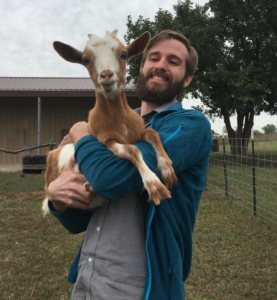
By: Kyle Haubrich
Kyle operated a pet sitting and dog walking company in Fort Collins Colorado for seven years. He sold his company in 2022 and founded Certified Pet Expert. He is CPS-DW certified and NAPPS certified. Kyle also volunteered at the Larimer Humane Society as a Behavior and Enrichment Specialist and is a regular foster parent for litters of kitties!


